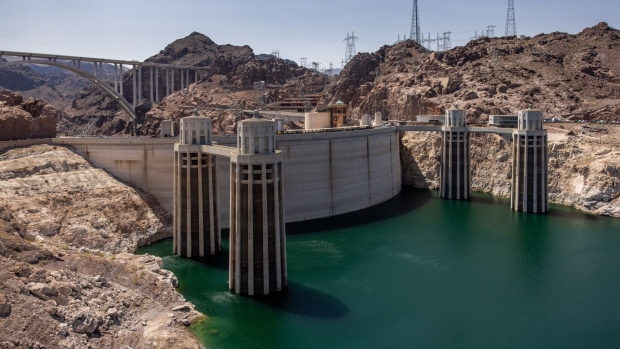Apr 11, 2023
US Plans Mandated Colorado River Water Cuts to Preserve Dams
, Bloomberg News

(Bloomberg Law) -- The Interior Department is poised to mandate water cuts on the Colorado River to prevent damage to two of the Southwest’s largest hydropower dams in the face of drought, a “dire” scenario the seven river basin states have tried hard to avoid.
Interior’s Bureau of Reclamation issued its draft environmental review of possible ways the agency will go about cutting Colorado River water use to protect Hoover and Glen Canyon dams on lakes Mead and Powell from low reservoir levels.
The agency is hoping states will come to an agreement for water cuts so the Interior Department won’t have to mandate them using the alternatives in the draft review, Deputy Interior Secretary Tommy Beaudreau said at an agency news conference Tuesday.
States are continuing work on their own solution because the bureau’s alternatives are likely to lead to opposition and litigation, which are “unacceptable outcomes,” Tom Buschatzke, director of the Arizona Department of Water Resources, said at the news conference.
The review is a high-stakes plan that determines how much water the 40 million people from Denver to Los Angeles, and the farmers who rely on the river, can use over the next two years, even amid one of the wettest, snowiest years on record. The bureau announced that it would begin planning for the cuts last year after historically low reservoir levels threatened both dams’ ability to generate hydropower.
The draft review lays out three possible ways the agency could cut water use to protect the dams: Do nothing at all; cut water use in the Lower Basin based on the priority of users’ water rights; or mandate a flat water use cut among all downstream water users in California, Arizona and Nevada.
Both alternatives to the status quo call for cutting flows from Glen Canyon Dam to maintain Lake Powell’s water level.
The proposed cuts are designed to prevent the shutdown of two of the largest hydroelectric dams in the US West, which supply electricity to millions of homes and businesses across eight states.
The basin is divided in two. Most of the river’s water comes from mountains in the upstream states of Colorado, Wyoming, Utah and New Mexico. By law, those states have to send water each year to the downstream states of California, Arizona and Nevada, where most of the region’s people live.
That water is stored in Lake Powell and is sent downstream through the Grand Canyon to Lake Mead, where the Lower Basin states store the water to be sent to Los Angeles, Phoenix and the farmers in between.
The first alternative, to cut water use based on priority, would cut more water use from Lake Mead depending on water level. All water rights in the West are prioritized based on who has held them the longest, and this alternative would respect that.
The second alternative, a flat cut, would take a different approach and spread the cuts among all Lower Basin water users at the same percentage.
“Drought conditions in the Colorado River Basin have been two decades in the making. To meet this moment, we must continue to work together, through a commitment to protecting the river, leading with science and a shared understanding that unprecedented conditions require new solutions,” Bureau of Reclamation Commissioner Camille Calimlim Touton said in a statement.
The draft review, which is expected to be finalized later this summer, revises 2007 interim guidelines for how to operate the dams amid water shortages before the guidelines expire in 2026. The bureau said it will use the final review to inform decisions it plans to make in August about how it will operate the dams in 2024. The agency will soon make the draft available for public comment for 45 days.
Calls for Consensus
Bureau officials said in December they wanted the seven Colorado River Basin states to come up with their own solution for how to cut water use to protect the dams amid the drought, and gave them until the end of January to submit proposals. So far, the states have failed to reach consensus.
Arizona, Nevada, Utah, Wyoming, New Mexico, and Colorado submitted a water-cutting proposal, but California submitted a conflicting plan.
Reclamation’s proposed options will lead to “dire consequences,” including lawsuits, Buschatzke said, calling for all seven states to reach a “consensus solution.”
California is also “looking to develop a true seven-state consensus,” said JB Hamby, chairman of the Colorado River Board of California, said at the news conference.
The Interior Department is still committed to finding other solutions and “reaching agreements” to conserve water in the basin, where there isn’t an “us vs. them dynamic” among states with different ideas about how to conserve water, Beaudreau said.
Sen. Mark Kelly (D-Ariz.) on Tuesday called for the states to reach consensus.
“Today’s announcement underscores the urgent need for basin states to take the lead by coming to a long-term agreement to protect the Colorado River system,” Kelly said in a statement.
— With assistance from Mark Chediak.
To contact the reporter on this story: Bobby Magill at bmagill@bloombergindustry.com
To contact the editors responsible for this story: Zachary Sherwood at zsherwood@bloombergindustry.com; Renee Schoof at rschoof@bloombergindustry.com
(Updated with reporting throughout.)
©2023 Bloomberg L.P.






